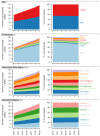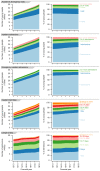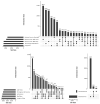Numbers, characteristics, and medical complexity of children with life-limiting conditions reaching age of transition to adult care in England: a repeated cross-sectional study [version 1; peer review: 2 approved]
- PMID: 35923178
- PMCID: PMC7613215
- DOI: 10.3310/nihropenres.13265.1
Numbers, characteristics, and medical complexity of children with life-limiting conditions reaching age of transition to adult care in England: a repeated cross-sectional study [version 1; peer review: 2 approved]
Abstract
Background: The number of children with life-limiting conditions in England is known to be increasing, which has been attributed in part to increased survival times. Consequently, more of these young people will reach ages at which they start transitioning to adult healthcare (14-19 years). However, no research exists that quantifies the number of young people with life-limiting conditions in England reaching transition ages or their medical complexity, both essential data for good service planning.
Methods: National hospital data in England (Hospital Episode Statistics) from NHS Digital were used to identify the number of young people aged 14-19 years from 2012/13 to 2018/19 with life-limiting conditions diagnosed in childhood. The data were assessed for indicators of medical complexity: number of conditions, number of main specialties of consultants involved, number of hospital admissions and Accident & Emergency Department visits, length of stay, bed days and technology dependence (gastrostomies, tracheostomies). Overlap between measures of complexity was assessed.
Results: The number of young people with life-limiting conditions has increased rapidly over the study period, from 20363 in 2012/13 to 34307 in 2018/19. There was evidence for increased complexity regarding the number of conditions and number of distinct main specialties of consultants involved in care, but limited evidence of increases in average healthcare use per person or increased technology dependence. The increasing size of the group meant that healthcare use increased overall. There was limited overlap between measures of medical complexity.
Conclusions: The number of young people with life-limiting conditions reaching ages at which transition to adult healthcare should take place is increasing rapidly. Healthcare providers will need to allocate resources to deal with increasing healthcare demands and greater complexity. The transition to adult healthcare must be managed well to limit impacts on healthcare resource use and improve experiences for young people and their families.
Keywords: Healthcare use; Life-limiting conditions; Medical complexity; Palliative care; Transition to adult care.
Conflict of interest statement
Competing interests: No competing interests were disclosed.
Figures










References
-
- Chambers L: A guide to children’s palliative care.4 ed. Bristol: Together for Short Lives;2018. Reference Source
Grants and funding
LinkOut - more resources
Full Text Sources
